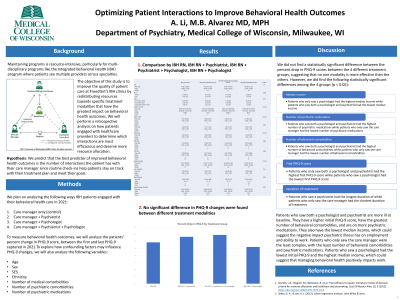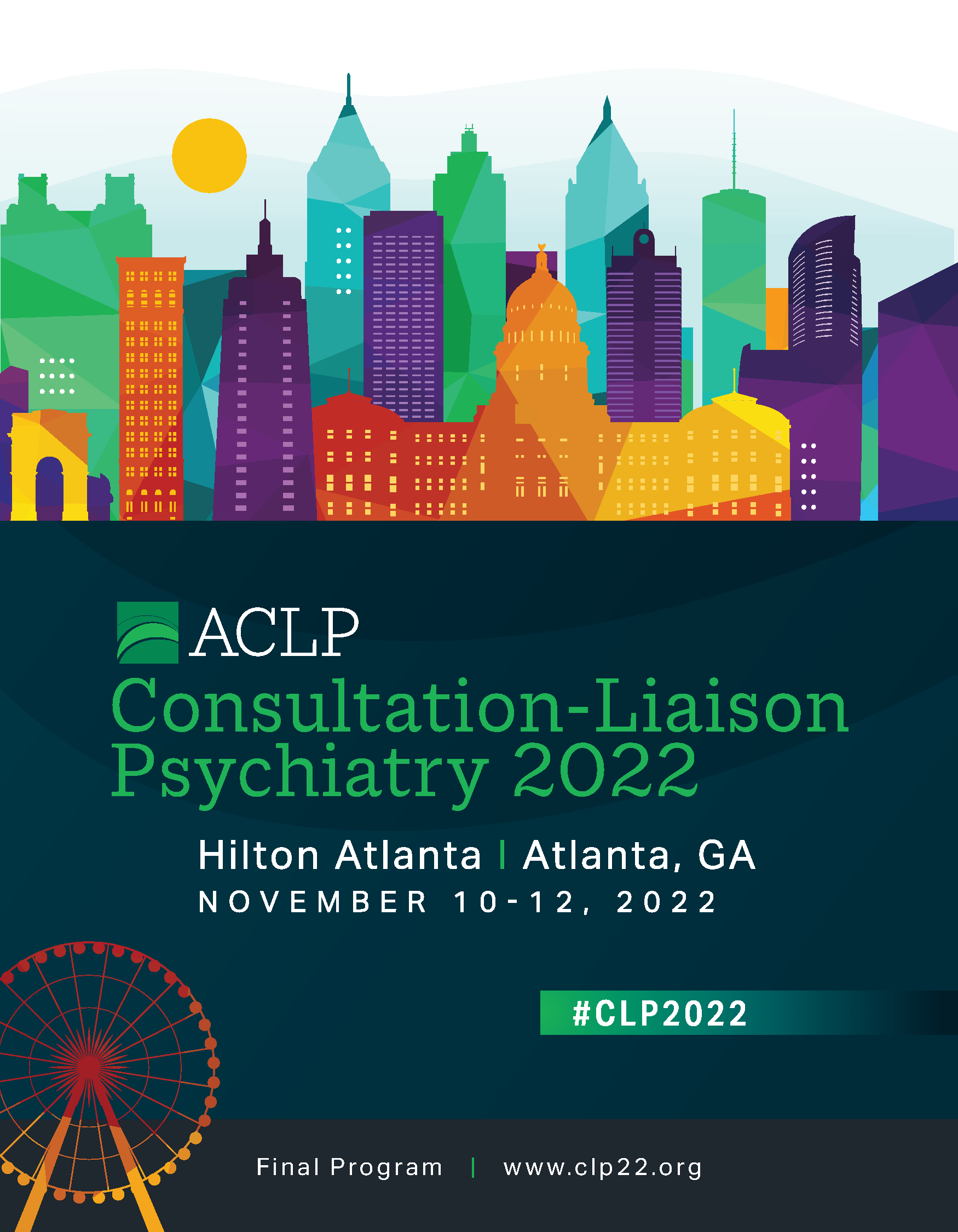Back

Quality and Safety
Poster Session
(147) Optimizing Patient Interactions to Improve Behavioral Health Outcomes

Abstract:
Background: Maintaining programs is resource-intensive, particularly for multi-disciplinary programs like the IBH program where patients receive care from multiple providers across specialties. For resource-intensive programs, it’s imperative that we allocate resources wisely by shifting to modalities that prove to be most efficacious1. By analyzing various forms of digital and human behavioral health interactions, we hope to reveal which is the best predictor of improved outcomes. Once we identify those treatment modalities, we can allocate more resources towards them to optimize patient care.
Methods: We will utilize medical record data from Froedtert’s IBH clinics and perform a retrospective analysis on how patients engaged with healthcare providers (both digital and human) to determine which interactions are most efficacious, and then we will allocate more resources towards those interactions. First we will identify all patients who had an active IBH episode in 2021 and engaged in any of the following treatments: psychiatrist visits, therapist visits, nurse visits, and SilverCloud (virtual mental health platform) use. For each treatment modality, we will gather how many times the patient engaged with that provider throughout the year by measuring the number of visits with the psychiatrist/therapist/nurse and the number of minutes the patient spent logged into SilverCloud. We will assess the patient’s behavioral health improvement by extracting their first and last recorded PHQ-9 score in 2021 and calculating the percent change. Then we will run a multiple regression analysis2 to determine which interaction or combination of interactions is statistically significant (p < 0.05) and has the greatest influence on behavioral health outcomes through reduction in the patients’ PHQ-9 scores.
Results: We are currently in the process of collecting data for this project and have not finalized our results. We hypothesize that the number of nurse visits has the strongest correlation with the percent change in patients’ PHQ-9 scores.
Discussion: The IBH program currently utilizes a variety of interdisciplinary providers to care for enrolled patients. Their services are all valuable resources that need to be allocated efficiently to reduce waste and optimize quality of care. Based on our findings, we can identify which service most directly influences patient outcomes by driving down their PHQ-9 scores. We can then use this information to guide decisions towards resource allocation.
Conclusion: Identifying which treatment modality is most efficacious towards patient improvement is critical to allocating resources in a way that reduces cost while improving outcomes.
References:
< !1. < Guindo, L.A., Wagner, M., Baltussen, R. et al. From efficacy to equity: Literature review of decision criteria for resource allocation and healthcare decisionmaking. Cost Eff Resour Alloc 10, 9 (2012). https://doi.org/10.1186/1478-7547-10-9
< 2. Seber, G. A., & Lee, A. J. (2012). Linear regression analysis. John Wiley & Son
Background: Maintaining programs is resource-intensive, particularly for multi-disciplinary programs like the IBH program where patients receive care from multiple providers across specialties. For resource-intensive programs, it’s imperative that we allocate resources wisely by shifting to modalities that prove to be most efficacious1. By analyzing various forms of digital and human behavioral health interactions, we hope to reveal which is the best predictor of improved outcomes. Once we identify those treatment modalities, we can allocate more resources towards them to optimize patient care.
Methods: We will utilize medical record data from Froedtert’s IBH clinics and perform a retrospective analysis on how patients engaged with healthcare providers (both digital and human) to determine which interactions are most efficacious, and then we will allocate more resources towards those interactions. First we will identify all patients who had an active IBH episode in 2021 and engaged in any of the following treatments: psychiatrist visits, therapist visits, nurse visits, and SilverCloud (virtual mental health platform) use. For each treatment modality, we will gather how many times the patient engaged with that provider throughout the year by measuring the number of visits with the psychiatrist/therapist/nurse and the number of minutes the patient spent logged into SilverCloud. We will assess the patient’s behavioral health improvement by extracting their first and last recorded PHQ-9 score in 2021 and calculating the percent change. Then we will run a multiple regression analysis2 to determine which interaction or combination of interactions is statistically significant (p < 0.05) and has the greatest influence on behavioral health outcomes through reduction in the patients’ PHQ-9 scores.
Results: We are currently in the process of collecting data for this project and have not finalized our results. We hypothesize that the number of nurse visits has the strongest correlation with the percent change in patients’ PHQ-9 scores.
Discussion: The IBH program currently utilizes a variety of interdisciplinary providers to care for enrolled patients. Their services are all valuable resources that need to be allocated efficiently to reduce waste and optimize quality of care. Based on our findings, we can identify which service most directly influences patient outcomes by driving down their PHQ-9 scores. We can then use this information to guide decisions towards resource allocation.
Conclusion: Identifying which treatment modality is most efficacious towards patient improvement is critical to allocating resources in a way that reduces cost while improving outcomes.
References:
< !1. < Guindo, L.A., Wagner, M., Baltussen, R. et al. From efficacy to equity: Literature review of decision criteria for resource allocation and healthcare decisionmaking. Cost Eff Resour Alloc 10, 9 (2012). https://doi.org/10.1186/1478-7547-10-9
< 2. Seber, G. A., & Lee, A. J. (2012). Linear regression analysis. John Wiley & Son

Anji Li (she/her/hers)
Medical Student
Medical College of Wisconsin
Wauwatosa, WI, United States
Mary Beth Alvarez, MD, MPH
Assistant Professor
Medical College of Wisconsin
Fox Point, Wisconsin, United States


